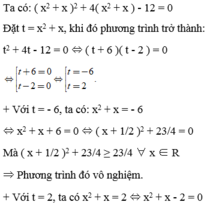giải phương trình: (x2+x)2 + 4 (x2+x)2 = 12
Hãy nhập câu hỏi của bạn vào đây, nếu là tài khoản VIP, bạn sẽ được ưu tiên trả lời.



⇔ ( x + 2 )( x - 1 ) = 0 ⇔ 
Vậy phương trình có tập nghiệm là S = { - 2;1 }.

1. Đặt $x^2+x=a$ thì pt trở thành:
$a^2+4a=12$
$\Leftrightarrow a^2+4a-12=0$
$\Leftrightarrow (a-2)(a+6)=0$
$\Leftrightarrow a-2=0$ hoặc $x+6=0$
$\Leftrightarrow x^2+x-2=0$ hoặc $x^2+x+6=0$
Dễ thấy $x^2+x+6=0$ vô nghiệm.
$\Rightarrow x^2+x-2=0$
$\Leftrightarrow (x-1)(x+2)=0$
$\Leftrightarrow x=1$ hoặc $x=-2$
2.
$x(x-1)(x+1)(x+2)=24$
$\Leftrightarrow [x(x+1)][(x-1)(x+2)]=24$
$\Leftrightarrow (x^2+x)(x^2+x-2)=24$
$\Leftrightarrow a(a-2)=24$ (đặt $x^2+x=a$)
$\Leftrightarrow a^2-2a-24=0$
$\Leftrightarrow (a+4)(a-6)=0$
$\Leftrightarrow a+4=0$ hoặc $a-6=0$
$\Leftrightarrow x^2+x+4=0$ hoặc $x^2+x-6=0$
Nếu $x^2+x+4=0$
$\Leftrightarrow (x+\frac{1}{2})^2=\frac{1}{4}-4<0$ (vô lý - loại)
Nếu $x^2+x-6=0$
$\Leftrightarrow (x-2)(x+3)=0$
$\Leftrightarrow x-2=0$ hoặc $x+3=0$
$\Leftrightarrow x=2$ hoặc $x=-3$

Lời giải:
Đặt $x^2+x=a$ thì pt trở thành:
$(a-2)(a-3)=12$
$\Leftrightarrow a^2-5a+6=12$
$\Leftrightarrow a^2-5a-6=0$
$\Leftrightarrow (a+1)(a-6)=0$
$\Leftrightarrow a+1=0$ hoặc $a-6=0$
$\Leftrightarrow x^2+x+1=0$ hoặc $x^2+x-6=0$
Nếu $x^2+x+1=0$
$\Leftrightarrow (x+\frac{1}{2})^2=-\frac{3}{4}<0$ (vô lý - loại)
Nếu $x^2+x-6=0$
$\Leftrightarrow (x-2)(x+3)=0$
$\Leftrightarrow x=2$ hoặc $x=-3$

\(\dfrac{1}{x+2}\)+\(\dfrac{5}{x-2}\)=\(\dfrac{2x-12}{x^2-4}\)
(đkxđ: x≠2, x≠-2)
⇔ \(\dfrac{x-2}{x^2-4}\)+\(\dfrac{5\left(x+2\right)}{x^2-4}\)= \(\dfrac{2x-12}{x^2-4}\)
⇔ x-2+5(x+2)=2x-12
⇔ x-2+5x+10=2x-12
⇔ 4x=-20
⇔ x=-5(tm)

a) x(4x + 2) = 4x2 - 14
⇔ 4x2 + 2x = 4x2 - 14
⇔ 4x2 - 4x2 + 2x = -14
⇔ 2x = -14
⇔ x = -7
Vậy tập nghiệm S = ......
b) (x2 - 9)(2x - 1) = 0
⇔ x2 - 9 = 0 hoặc 2x - 1 = 0
⇔ x2 = 9 hoặc 2x = 1
⇔ x = 3 hoặc -3 hoặc x = \(\dfrac{1}{2}\)
Vậy .......
c) \(\dfrac{3}{x-2}\) + \(\dfrac{4}{x+2}\) = \(\dfrac{x-12}{x^2-4}\)
⇔ \(\dfrac{3}{x-2}\) + \(\dfrac{4}{x+2}\) = \(\dfrac{x-12}{\left(x-2\right)\left(x+2\right)}\)
ĐKXĐ: x - 2 ≠ 0 và x + 2 ≠ 0
⇔ x ≠ 2 và x ≠ -2MSC (mẫu số chung): (x - 2)(x + 2)Quy đồng mẫu hai vế và khử mẫu ta được:3x + 6 + 4x - 8 = x - 12⇔ 3x + 4x - x = 8 - 6 - 12⇔ 6x = -10⇔ x = \(-\dfrac{5}{3}\) (nhận)Vậy ........
( x + 1 ) 2 ( x 2 + 4 ) = x 2 − x − 2 (1)
Điều kiện: x2 + 4 ≥ 0 (luôn đùng ∀ x)
( 1 ) ⇔ ( x + 1 ) 2 ( x 2 + 4 ) = ( x − 2 ) ( x + 1 ) ⇔ ( x + 1 ) 2 ( x 2 + 4 ) − ( x − 2 ) = 0 ⇔ x = − 1 2 ( x 2 + 4 ) = x − 2 ( 2 )
Có ( 2 ) ⇔ x ≥ 2 2 ( x 2 + 4 ) = x - 2 2 ⇔ x ≥ 2 x 2 + 4 x + 4 = 0 ⇔ x ≥ 2 x = − 2 (loại)
Vậy tập nghiệm của phương trình đã cho là {–1}

\(a,=>x^3-2x^2+4x+2x^2-4x+8-x^3+2x-15=0\)
\(< =>2x-7=0< =>x=\dfrac{7}{2}\)
b,\(=>x\left(x^2-25\right)-\left(x+2\right)\left(x^2-2x+4\right)-3=0\)
\(< =>x^3-25x-x^3+2x^2-4x-2x^2+4x-8-3=0\)
\(< =>-25x-11=0\)
\(< =>x=-0,44\)

a) \(\left(x^2+2\right)^2-\left(x+2\right)\left(x-2\right)\left(x^2+4\right)-4x\left(x+1\right)\le20\)
\(\Leftrightarrow x^4+4x^2+4-x^4+16-4x^2-4x\le20\)
\(\Leftrightarrow\left(x^4-x^4\right)+\left(4x^2-4x^2\right)-4x+4+16\le20\)
\(\Leftrightarrow-4x+20\le20\)
\(\Leftrightarrow-4x\le20-20\)
\(\Leftrightarrow-4x\le0\)
\(\Leftrightarrow-4x:-4\ge0:-4\)
\(\Leftrightarrow x\ge0\)
Vậy nghiệm của bất phương trình là: \(x\ge0\)
b) \(\left(x+2\right)\left(x^2-2x+4\right)-x\left(x^2+2\right)\ge15\)
\(\Leftrightarrow x^3+8-x^3-2x\ge15\)
\(\Leftrightarrow\left(x^3-x^3\right)+8-2x\ge15\)
\(\Leftrightarrow8-2x\ge15\)
\(\Leftrightarrow-2x\ge15-8\)
\(\Leftrightarrow-2x\ge7\)
\(\Leftrightarrow-2x:-2\le7:-2\)
\(\Leftrightarrow x\le-\dfrac{7}{2}\)
Vậy nghiệm của bất phương trình là \(x\le-\dfrac{7}{2}\)
a: =>x^4+4x^2+4-x^4+16-4x^2-4x<=20
=>-4x+20<=20
=>-4x<=0
=>x>=0
b: =>x^3+8-x^3-2x>=15
=>-2x>=7
=>x<=-7/2

a: Đặt \(a=x^2+x\)
Phương trình ban đầu sẽ trở thành \(a^2+4a-12=0\)
=>\(a^2+6a-2a-12=0\)
=>a(a+6)-2(a+6)=0
=>(a+6)(a-2)=0
=>\(\left(x^2+x+6\right)\left(x^2+x-2\right)=0\)
=>\(x^2+x-2=0\)(Vì \(x^2+x+6=\left(x+\dfrac{1}{2}\right)^2+\dfrac{23}{4}>0\forall x\))
=>\(\left(x+2\right)\left(x-1\right)=0\)
=>\(\left[{}\begin{matrix}x+2=0\\x-1=0\end{matrix}\right.\Leftrightarrow\left[{}\begin{matrix}x=-2\\x=1\end{matrix}\right.\)
b:
Sửa đề: \(\left(x^2+2x+3\right)^2-9\left(x^2+2x+3\right)+18=0\)
Đặt \(b=x^2+2x+3\)
Phương trình ban đầu sẽ trở thành \(b^2-9b+18=0\)
=>\(b^2-3b-6b+18=0\)
=>b(b-3)-6(b-3)=0
=>(b-3)(b-6)=0
=>\(\left(x^2+2x+3-3\right)\left(x^2+2x+3-6\right)=0\)
=>\(\left(x^2+2x\right)\left(x^2+2x-3\right)=0\)
=>\(x\left(x+2\right)\left(x+3\right)\left(x-1\right)=0\)
=>\(\left[{}\begin{matrix}x=0\\x+2=0\\x+3=0\\x-1=0\end{matrix}\right.\Leftrightarrow\left[{}\begin{matrix}x=0\\x=-2\\x=-3\\x=1\end{matrix}\right.\)
c: \(\left(x-2\right)\left(x+2\right)\left(x^2-10\right)=72\)
=>\(\left(x^2-4\right)\left(x^2-10\right)=72\)
=>\(x^4-14x^2+40-72=0\)
=>\(x^4-14x^2-32=0\)
=>\(\left(x^2-16\right)\left(x^2+2\right)=0\)
=>\(x^2-16=0\)(do x2+2>=2>0 với mọi x)
=>x2=16
=>x=4 hoặc x=-4
Đặt t=x2+x
pt <=> x^4 + 2x^3 + x^2 + 4x^2 + 4x - 12 = 0
<=> x^4 + 2x^3 + 5x^2 + 4x - 12 = 0
<=> (x-1)(x^3+3x^2+8x+12) = 0 (áp dụng biểu đồ hoocner)
tiếp theo bạn giải pt bậc 3 bằng máy tính bỏ túi.
Cũng không chắc nữa mà Minh Triều là cộng tác viên đời trước chứ nhể